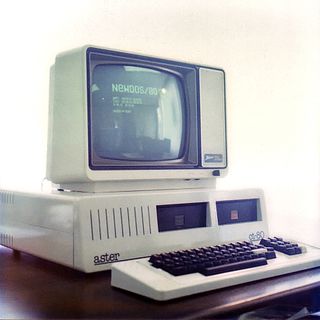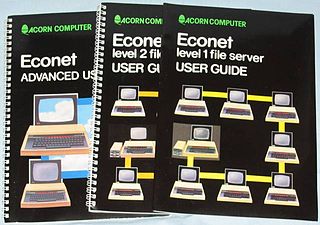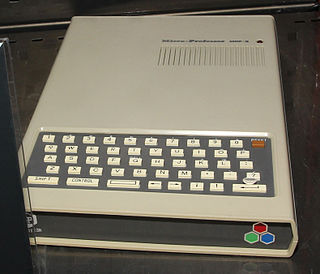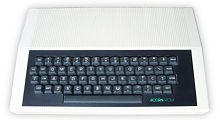
The Acorn Electron was a lower-cost alternative to the BBC Micro educational/home computer, also developed by Acorn Computers Ltd, to provide many of the features of that more expensive machine at a price more competitive with that of the ZX Spectrum. It had 32 kilobytes of RAM, and its ROM included BBC BASIC II together with the operating system. Announced in 1982 for a possible release the same year, it was eventually introduced on 25 August 1983 priced at £199.

The Aster CT-80, an early (1982) home/personal computer developed by the small Dutch company MCP, was sold in its first incarnation as a kit for hobbyists. Later it was sold ready to use. It consisted of several Eurocard PCB's with DIN 41612 connectors, and a backplane all based on a 19-inch rack configuration. It was the first commercially available Dutch personal/home computer. The Aster computer could use the software written for the popular Tandy TRS-80 computer while fixing many of the problems of that computer, but it could also run CP/M software, with a large amount of free memory Transient Program Area, (TPA) and a full 80×25 display, and it could be used as a Videotext terminal. Although the Aster was a clone of the TRS-80 Model I it was in fact more compatible with the TRS-80 Model III, and ran all the software of these systems including games. It also had a built in speaker which was compatible with such games software.

The Acorn Atom is a home computer made by Acorn Computers Ltd from 1979 to 1982, when it was replaced by the BBC Micro. The BBC Micro began life as an upgrade to the Atom, originally known as the Proton.

MicroBee was a series of networkable home computers by Applied Technology, which became publicly listed company MicroBee Systems Limited soon after its release. The original Microbee computer was designed in Australia by a team including Owen Hill and Matthew Starr.

The Compukit UK101 microcomputer (1979) is a kit clone of the Ohio Scientific Superboard II single-board computer, with a few enhancements for the UK market - notably replacing the 24×24 screen display with a more useful 48×16 layout working at UK video frequencies. The video output is black and white with 256 semigraphic characters generated by a two kilobyte ROM. It has no bit-mapped graphics capability. The video is output through a UHF modulator, designed to connect to a TV set.

Econet was Acorn Computers's low-cost local area network system, intended for use by schools and small businesses. It was widely used in those areas, and was supported by a large number of different computer and server systems produced both by Acorn and by other companies.

The Acorn System 1, initially called the Acorn Microcomputer (Micro-Computer), was an early 8-bit microcomputer for hobbyists, based on the MOS 6502 CPU, and produced by British company Acorn Computers from 1979.
The Acorn Communicator is a discontinued business computer developed by Acorn Computers. Mentioned in the computing press in late 1984 as the C30, previewed in early 1985 with estimated pricing between £500 and £800, in late 1985 with a built-in LCD display, and subsequently unveiled in a slightly different form, the system sold in very low numbers to companies requiring a computer with a built-in modem.

Microprofessor II, introduced in 1982, was Multitech's second branded computer product and also one of the earliest Apple II clones. It does not look like most other computers. The case of the MPF II was a slab with a small chiclet keyboard on its lower part.

Miracle Systems Ltd. were a manufacturer of personal computer peripherals and upgrades, specializing in the Sinclair QL, in the 1980s and early 1990s.

This article is about the various external peripherals of the Commodore 64 home computer. Due to the backwards compatibility of the Commodore 128, most peripherals will work on that system, as well. There's some compatibility with the VIC-20 and PET too.

The Machine Operating System (MOS) or OS is a discontinued computer operating system (OS) used in Acorn Computers' BBC computer range. It included support for four-channel sound, graphics, file system abstraction, and digital and analogue input/output (I/O) including a daisy-chained expansion bus. The system was single-tasking, monolithic and non-reentrant.

The Research Machines 380Z was an early 8-bit microcomputer produced by Research Machines in Oxford, England, from 1977 to 1985.

A BBC Micro expansion unit, for the BBC Micro is one of a number of peripherals in a box with the same profile and styling as the main computer.

The Dick Smith Super-80 was a Zilog Z80 based kit computer developed as a joint venture between Electronics Australia magazine and Dick Smith Electronics.

The Elektor Junior Computer was a simple 6502-based microprocessor development board published in the 1980s in the Dutch, German and later French, Spanish, British and Indian versions of Elektor/Elektuur, in the form of a series of articles, and four books. It was developed by the German engineer Loys Nachtmann.

The British Broadcasting Corporation Microcomputer System, or BBC Micro, is a series of microcomputers and associated peripherals designed and built by Acorn Computers in the 1980s for the BBC Computer Literacy Project. Designed with an emphasis on education, it was notable for its ruggedness, expandability, and the quality of its operating system. An accompanying 1982 television series, The Computer Programme, featuring Chris Serle learning to use the machine, was broadcast on BBC2.
PolyMorphic Systems was a manufacturer of microcomputer boards and systems based on the S-100 bus. Their products included the Poly-88 and the System 8813. The company was incorporated in California in 1976 as Interactive Products Corporation d/b/a PolyMorphic Systems. It was initially based in Goleta, then Santa Barbara, California.
N8VEM was a homebrew computing project. It featured a variety of free and open hardware and software. N8VEM builders made their own homebrew computer systems for themselves and shared their experiences with other homebrew computer hobbyists. N8VEM homebrew computer components are made in the style of vintage computers of the mid to late 1970s and early 1980s using a mix of classic and modern technologies. They are designed with ease of amateur assembly in mind.
The ENER 1000 was a Portuguese computer released in 1982. It had 64 KB RAM and two 5+1⁄4-inch double-density floppy disk drives. It ran the CP/M operating system.

















